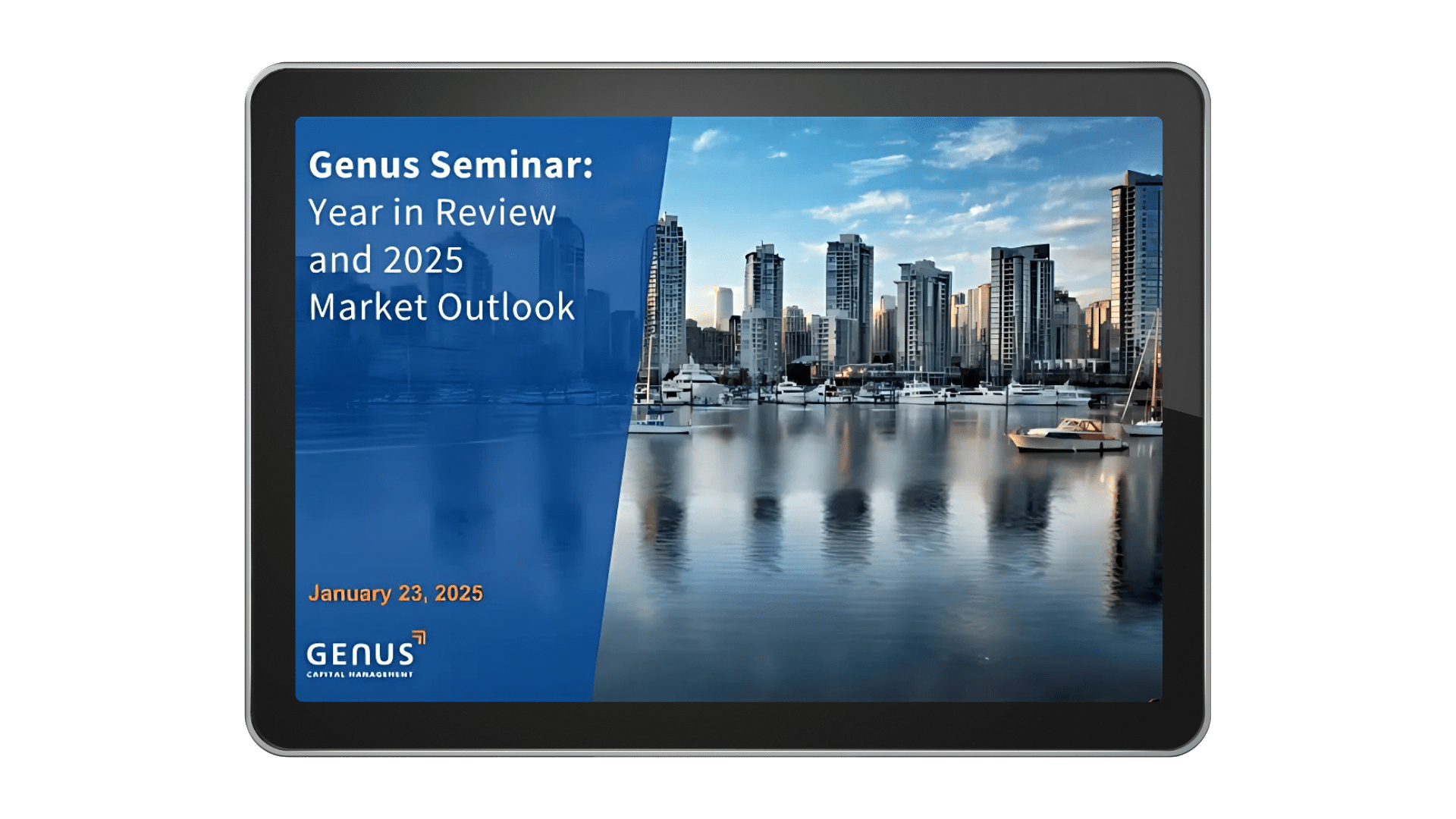Tom Holloway: [00:00:02] Hi, I’m Tom Holloway and I’m a business strategist at Genus Capital.
Justin Hahn: [00:00:07] I am Justin Hahn, I’m a maco research analyst for the investment team.
Tom Holloway: [00:00:12] Thanks for joining me today, Justin. And I’ll say that the topic that we’re planning to talk about today is when should investors change their investments? What I started by doing is thinking about the word change in that topic. And the word change made me think about the news. I mean, that’s one of the places. Why would you make a change? Well, it’s got to be because there’s new information. And one of the places we get new information is the news anyway. I think that that’s the right way to think about change.
We have to think about what’s what’s new. So my my dog, for example, uses the same heuristic. We’re walking around the neighborhood, and if she sees something new that wasn’t there yesterday, she starts barking like crazy. She doesn’t maybe know what to do with the information, but she’s observing that something something’s changed, something new. Let’s go there with the with the investment portfolio, Justin. You do this day to day. So what’s new in the market and what’s what’s new in the portfolio in the last week?
Justin Hahn: [00:01:11] Thanks, Tom. So this week was actually a very quiet week for the markets and in terms of macro data. In the markets we saw hit new highs middle of the week, all time highs, but ended up falling and have been range bound quite a bit around that level. In terms of big macroeconomic updates, most of it was quiet. There was some updates regarding the US China trade talks. There were scheduled meetings. But other sources are saying that there aren’t scheduled meetings, mixed reports they’re adding to the more flatness of the markets this week. Today, we got a really good housing number data out of the US where we saw housing numbers rise up twenty five percent and we believe that this will continue as a trend with people moving out of the big metropolitan areas, moving more towards the suburbs. So the tricky part for us as a team is not observing and understanding all the news. I think the hardest part is having the judgment to know what’s important and navigating through all the noise and fluff that’s going on, especially given the new administration with tweets and whatnot and new technological advancements. How do you think how do you think about this judgment layer Tom?
Tom Holloway: [00:02:22] Yeah, it’s a great question and and I think where we’re headed with this is that, of course, when would you change your portfolio, you would change your portfolio when the information changes, so that’s a sensible, logical statement. But as Justin said, there’s the trouble with the investing business is that we’re just bombarded with new information. And some one day some of it might be important, but a lot of times a lot of it isn’t. So there’s really two big questions. As Justin said, what’s important and increasingly we even have the question of what’s real. I think we’ve all heard the expression fake news. A good word for that is judgment. And you probably can anticipate my answer a little bit here. But where does judgment come from? Judgment comes from experience. And you might have heard the quip that where does experience come from? Well, it comes from bad judgment. On the other hand, I think we have to be careful. We want we don’t want to have too much experience building in a professional context. And so we need to have ways of building up experience without without learning it the hard way. You know, there’s only so much experience you can build up in your own career, especially in investment cycles. We only get an economic cycle roughly every 10 or 12 years. We need to be able to learn experiences over dozens of cycles and none of us live that long. So this is one of the problems of investing. So it absolutely has to come from reading and and data. And that helps me come come around to the Genus process, which I love talking about, because it’s data. We don’t just look at the last two cycles. We are looking at decades of data and last time housing was strong, what happened to interest rates the next year or last time housing was strong, what happened to lumber prices?
Justin Hahn: [00:04:11] Right. Thanks. I think that’s a good point. It’s also important to note that a lot of these cycles and a lot of these corrections are all caused by quite different things, such as this time around, it was the covid crisis where it doesn’t happen very often. And a couple of times ago, the financial sector crashing. So it’s always a little different. But with data, we’re able to kind of pinpoint exactly what are the similarities in terms of a more micro level. Moving on, let’s look at today’s topic. So today’s topic revolves around when investors should change their investment. Presumably, I believe it’s when something is new or as you mentioned, new information comes out.
Tom Holloway: [00:04:48] Know really what is the answer? When should an investor make changes? For me, the answer really has two pieces. The first one I call strategic asset allocation. This is all to do with the client themselves. The client situation, what are the what are the client goals? And the important thing about that is it doesn’t change very often. That’s why we call it strategic asset allocation. It can change, but it should change in response to something going on in the client’s life, for example, an unexpected change in career and inheritance. And then there’s a second whole piece of it, which we have a nice name for. We call it tactical asset allocation. The tactical asset allocation does respond to changes in the market. If suddenly things are really, really cheap, I think we should own slightly more of that asset. Or if it risks change based on the information that we’re receiving, then it can make sense to reposition the portfolio. Now, the types of changes that we see in tactical asset allocation are much smaller, one or two or three percent of the portfolio at a time. So that so the two points I want to make is, first of all, that those are separate, but also that there’s always a poll which tries to kind of confuse the two. And we have to be working really hard as professionals and as clients to make sure we remember that those two things are separate. Anyway, let’s spend a bit more time on the technical side. So this is a pure investment problem, but it’s got to do with when you intentionally buy more stocks than when you intentionally buy fewer stocks. Justin, why don’t you take us through that? Because that’s kind of more your day job, I think.
Justin Hahn: [00:06:26] Yeah. So tech that allocation, in short, is just an investment strategy that is based on more of a top down research that we hear at Genus employ. Big goal of this is to shift weights between different asset classes such as bonds, cash and equities, as well as within those asset classes favoring different regions. Maybe the US economic growth is much stronger as we’ve seen, and we’ll see those things change in the data and we have models that build upon that data. At Genus, we have more more than over 20 models that we use and we look at from an asset allocation perspective in the recent months, what we’ve been focusing on and what we’ve noticed is we’ve seen a lot of the commodity sectors being heavily favored by our models. This gives us more of a view that an economic recovery is taking place and is under way.
Tom Holloway: [00:07:16] Great. OK, so I’m just going to wrap it up and summarize by saying some key points. If an investor is asking the question when when the things change there, it’s not a correct answer to say nothing changes, everything’s fine. That’s taking it a little too easy. But but what we can do is put a framework over why and when things should change. So, of course, changes in the portfolio should come from changes in the real world. And those changes can take a couple of different forms. And that type of work is called strategic asset allocation and making sure that there’s a perfect alignment between what’s going on in the client’s real life and in the portfolio life. And so I think if we’re doing our job well as a firm, then both on the client facing side and the investment facing side. We have a clearly articulated process and we keep updating that really frequently and so that everybody’s really clear about what what we’re doing and what changes we’re seeing and what we’re doing about it. But at the end of the day, you know what? We all read the news. We’re all watching video, news and Twitter news and and Internet news. And there’s a lot of changes all the time. And it always has. It’s always pulling us back to that question of should I change the portfolio?
Justin Hahn: [00:08:35] Yeah, that’s great. I guess we’ll just leave it here today. Thanks, Tom, and thanks, everyone, for listening.
Tom Holloway: [00:08:42] Great, thanks for the chat. Justin.











